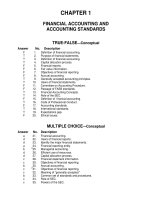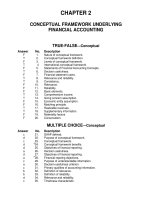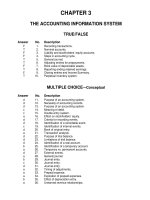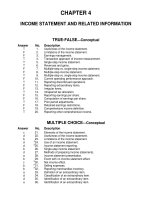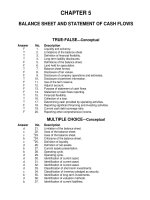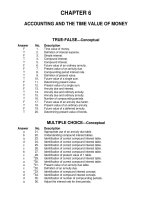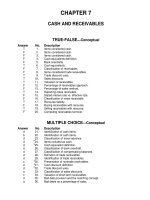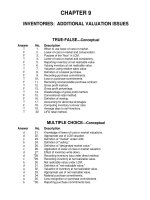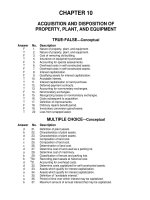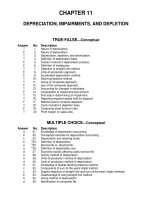Test bank with answers intermediate accounting 12e by kieso chapter 03
Bạn đang xem bản rút gọn của tài liệu. Xem và tải ngay bản đầy đủ của tài liệu tại đây (125.02 KB, 39 trang )
To download more slides, ebook, solutions and test bank, visit
CHAPTER 3
THE ACCOUNTING INFORMATION SYSTEM
TRUE/FALSE
Answer
F
T
F
F
T
T
F
T
F
T
No.
Description
1.
2.
3.
4.
5.
6.
7.
8.
9.
10.
Recording transactions.
Nominal accounts.
Liability and stockholders’ equity accounts.
Steps in accounting cycle.
General journal.
Adjusting entries for prepayments.
Book value of depreciable assets.
Reporting ending retained earnings.
Closing entries and Income Summary.
Perpetual inventory system.
MULTIPLE CHOICE—Conceptual
Answer
d
d
d
c
c
a
d
d
c
d
a
d
d
d
b
a
d
a
b
c
d
a
a
a
b
a
No.
Description
11.
12.
13.
14.
15.
16.
17.
18.
19.
20.
21.
22.
23.
24.
25.
26.
27.
28.
29.
30.
31.
32.
33.
34.
35.
36.
Purpose of an accounting system.
Necessity of accounting records.
Purpose of an accounting system.
Meaning of debit.
Double-entry system.
Effect on stockholders’ equity.
Criteria for recording events.
Identification of a recordable event.
Identification of internal events.
Book of original entry.
Transaction analysis.
Purpose of trial balance.
Limitations of trial balance.
Identification of a real account.
Identification of a temporary account.
Temporary vs. permanent accounts.
External events.
General journal.
Journal entry.
Journal entry.
Journal entry.
Timing of adjustments.
Prepaid expense.
Expiration of prepaid expenses.
Effect of depreciation entry.
Unearned revenue relationships.
To download more slides, ebook, solutions and test bank, visit
Test Bank for Intermediate Accounting, Twelfth Edition
3-2
a
d
c
a
d
c
d
c
d
d
d
b
c
b
b
c
c
c
d
c
c
c
d
d
37.
38.
39.
40.
41.
42.
43.
44.
45.
46.
47.
48.
49.
50.
51.
52.
53.
54.
*55.
*56.
*57.
*58.
*59.
*60.
Computation of interest expense for adjusting entry.
Purpose of adjusting entries.
Matching principle.
Prepaid items.
Accrued items.
Definition of unearned revenue.
Definition of accrued expense.
Adjusting entry for accrued expense.
Factors to consider in estimating depreciation.
Adjusting entries.
Effect of adjusting entries.
Prepaid expense and the matching principle.
Accrued revenue and the matching principle.
Unearned revenue and the matching principle.
Adjusted trial balance.
Closing entry process.
Year-end inventory adjustment.
Effect of understanding ending inventory.
Cash basis revenue.
Convert cash receipts to service revenue.
Convert cash paid for operating expenses.
Purpose of reversing entries.
Identification of reversing entries.
Identification of reversing entries.
MULTIPLE CHOICE—Computational
AnswerNo.
Description
c
c
c
c
a
d
d
c
b
b
c
c
d
d
c
b
b
d
c
c
c
Effect of transactions on owners’ equity.
Effect of transactions on owners’ equity.
Unearned rent adjustment.
Unearned rent adjustment.
Determine adjusting entry.
Determine adjusting entry.
Determine adjusting entry.
Adjusting entry for bad debts.
Adjusting entry for bad debts.
Unearned rent adjustment.
Adjusting entry for interest receivable.
Subsequent period entry for interest.
Use of reversing entry.
Effect of closing entries.
Calculate commission expense for the year.
Calculate cash received for interest.
Calculate cash paid for salaries.
Calculate cash paid for insurance.
Calculate insurance expense.
Calculate interest revenue.
Calculate salary expense.
61.
62.
63.
64.
*65.
*66.
67.
68.
69.
*70.
71.
72.
*73.
74.
*75.
*76.
*77.
*78.
*79.
*80.
*81.
To download more slides, ebook, solutions and test bank, visit
The Accounting Information System
c
c
b
*82.
*83.
*84.
Reversing entries.
Calculate total purchases.
Calculate cost of goods sold.
MULTIPLE CHOICE—CPA Adapted
Answer
c
b
a
c
b
b
a
d
b
c
b
a
No.
85.
86.
87.
88.
89.
90.
91.
92.
*93.
*94.
*95.
*96.
Description
Determine accrued interest payable.
Determine balance of unearned revenues.
Calculate subscriptions revenue.
Determine interest receivable.
Calculate balance of accrued payable.
Calculate accrued salaries.
Calculate royalty revenue.
Calculate deferred revenue.
Difference between cash basis and accrual method.
Determine cash basis revenue.
Determine accrual basis revenue.
Calculate cost of goods sold.
*This topic is dealt with in an Appendix to the chapter.
EXERCISES
Item
E3-97
E3-98
E3-99
E3-100
E3-101
E3-102
*E3-103
*E3-104
*E3-105
*E3-106
*E3-107
Description
Definitions.
Terminology.
Accrued and deferred items.
Adjusting entries.
Adjusting entries.
Financial statements.
Cash basis vs. accrual basis accounting.
Accrual basis.
Accrual basis.
Accrual basis.
Cash basis.
PROBLEMS
Item
P3-108
P3-109
P3-110
*P3-111
*P3-112
*P3-113
*P3-114
Description
Adjusting entries and account classifications.
Adjusting entries.
Adjusting and closing entries.
Cash to accrual accounting.
Accrual accounting.
Accrual accounting.
Eight-column work sheet.
3-3
To download more slides, ebook, solutions and test bank, visit
3-4
Test Bank for Intermediate Accounting, Twelfth Edition
CHAPTER LEARNING OBJECTIVES
1.
Understand basic accounting terminology.
2.
Explain double-entry rules.
3.
Identify steps in the accounting cycle.
4.
Record transactions in journals, post to ledger accounts, and prepare a trial balance.
5.
Explain the reasons for preparing adjusting entries.
6.
Prepare financial statements from the adjusted trial balance.
7.
Prepare closing entries.
8.
Explain how to adjust inventory accounts at year-end.
*9.
Differentiate the cash basis of accounting from the accrual basis of accounting.
*10.
Identify adjusting entries that may be reversed.
*11.
Prepare a 10-column worksheet.
To download more slides, ebook, solutions and test bank, visit
The Accounting Information System
3-5
SUMMARY OF LEARNING OBJECTIVES BY QUESTIONS
Item
Type
Item
Type
Item
1.
2.
TF
TF
11. MC
12. MC
13.
20.
3.
TF
14.
MC
15.
4.
TF
17.
MC
18.
5.
TF
22.
23.
MC
MC
29.
6.
7.
32.
33.
34.
35.
36.
37.
38.
TF
TF
MC
MC
MC
MC
MC
MC
MC
8.
TF
9.
TF
10.
TF
55.
56.
57.
75.
MC
MC
MC
MC
58.
MC
114.
P
Note:
39.
40.
41.
42.
43.
44.
45.
46.
47.
MC
MC
MC
MC
MC
MC
MC
MC
MC
48.
49.
50.
63.
64.
67.
68.
69.
71.
MC
102.
MC
74.
MC
54.
76.
77.
78.
79.
MC
MC
MC
MC
80.
81.
83.
84.
59.
MC
60.
51.
52.
53.
TF = True/False
MC = Multiple Choice
Type
Item
Type
Item
Learning Objective 1
MC
22. MC
25.
MC
24. MC
98.
Learning Objective 2
MC
16. MC
21.
Learning Objective 3
MC
19. MC
26.
Learning Objective 4
MC
30. MC
31.
Learning Objective 5
MC
72. MC
97.
MC
85. MC
98.
MC
86. MC
99.
MC
87. MC
100.
MC
88. MC
101.
MC
89. MC
MC
90. MC
MC
91. MC
MC
92. MC
Learning Objective 6
E
Learning Objective 7
MC
110.
P
Learning Objective 8
MC
100.
E
108.
Learning Objective *9
MC
93. MC
103.
MC
94. MC
104.
MC
95. MC
105.
MC
96. MC
106.
Learning Objective *10
MC
65. MC
82.
66. MC
73. MC
Learning Objective *11
E = Exercise
P = Problem
Type
Item
Type
Item
Type
MC
E
MC
MC
27.
MC
28.
MC
MC
61.
MC
62.
MC
E
E
E
E
E
108.
109.
P
P
110.
P
P
110.
P
E
E
E
E
107.
111.
112.
113.
E
P
P
P
MC
101.
E
To download more slides, ebook, solutions and test bank, visit
3-6
Test Bank for Intermediate Accounting, Twelfth Edition
TRUE/FALSE
1.
A ledger is where the company initially records transactions and selected other events.
2.
Nominal (temporary) accounts are revenue, expense, and dividend accounts and are
periodically closed.
3.
All liability and stockholders’ equity accounts are increased on the credit side and
decreased on the debit side.
4.
The first step in the accounting cycle is the journalizing of transactions and selected
other events.
5.
A general journal chronologically lists transactions and other events, expressed in terms
of debits and credits to accounts.
6.
Adjusting entries for prepayments record the portion of the prepayment that represents
the expense incurred or the revenue earned in the current accounting period.
7.
The book value of any depreciable asset is the difference between its cost and its
salvage value.
8.
The ending retained earnings balance is reported on both the retained earnings
statement and the balance sheet.
9.
All revenues, expenses, and the dividends account are closed through the Income
Summary account.
10.
With a perpetual inventory system, a company records purchases and sales directly in
the Inventory account as the purchases and sales occur.
MULTIPLE CHOICE—Conceptual
11.
Factors that shape an accounting information system include the
a. nature of the business.
b. size of the firm.
c. volume of data to be handled.
d. all of these.
12.
Maintaining a set of accounting records is
a. optional.
b. required by the Internal Revenue Service.
c. required by the Foreign Corrupt Practices Act.
d. required by the Internal Revenue Service and the Foreign Corrupt Practices Act.
To download more slides, ebook, solutions and test bank, visit
The Accounting Information System
3-7
13.
Debit always means
a. right side of an account.
b. increase.
c. decrease.
d. none of these.
14.
The double-entry accounting system means
a. Each transaction is recorded with two journal entries.
b. Each item is recorded in a journal entry, then in a general ledger account.
c. The dual effect of each transaction is recorded with a debit and a credit.
d. More than one of the above.
15.
When a corporation pays a note payable and interest,
a. the account notes payable will be increased.
b. the account interest expense will be decreased.
c. they will debit notes payable and interest expense.
d. they will debit cash.
16.
Stockholders’ equity is not affected by all
a. cash receipts.
b. dividends.
c. revenues.
d. expenses.
17.
Which of the following criteria must be met before an event or item should be recorded for
accounting purposes?
a. The event or item can be measured objectively in financial terms.
b. The event or item is relevant and reliable.
c. The event or item is an element.
d. All of these must be met.
18.
Which of the following is a recordable event or item?
a. Changes in managerial policy
b. The value of human resources
c. Changes in personnel
d. None of these
19.
Which of the following is not an internal event?
a. Depreciation
b. Using raw materials in the production process
c. Dividend declaration and subsequent payment
d. All of these are internal transactions.
20.
An accounting record into which the essential facts and figures in connection with all
transactions are initially recorded is called the
a. ledger.
b. account.
c. trial balance.
d. none of these.
To download more slides, ebook, solutions and test bank, visit
3-8
Test Bank for Intermediate Accounting, Twelfth Edition
21.
The debit and credit analysis of a transaction normally takes place
a. before an entry is recorded in a journal.
b. when the entry is posted to the ledger.
c. when the trial balance is prepared.
d. at some other point in the accounting cycle.
22.
A trial balance
a. proves that debits and credits are equal in the ledger.
b. supplies a listing of open accounts and their balances that are used in preparing
financial statements.
c. is normally prepared three times in the accounting cycle.
d. all of these.
23.
A trial balance may prove that debits and credits are equal, but
a. an amount could be entered in the wrong account.
b. a transaction could have been entered twice.
c. a transaction could have been omitted.
d. all of these.
24.
Which of the following is a real (permanent) account?
a. Goodwill
b. Sales
c. Accounts Receivable
d. Both Goodwill and Accounts Receivable
25.
Which of the following is a nominal (temporary) account?
a. Unearned Revenue
b. Salary Expense
c. Inventory
d. Retained Earnings
26.
Nominal accounts are also called
a. temporary accounts.
b. permanent accounts.
c. real accounts.
d. none of these.
27.
External events do not include
a. interaction between an entity and its environment.
b. a change in the price of a good or service that an entity buys or sells, a flood or
earthquake.
c. improvement in technology by a competitor.
d. using buildings and machinery in operations.
28.
A general journal
a. chronologically lists transactions and other events, expressed in terms of debits and
credits.
b. contains one record for each of the asset, liability, stockholders’ equity, revenue, and
expense accounts.
c. lists all the increases and decreases in each account in one place.
d. contains only adjusting entries.
To download more slides, ebook, solutions and test bank, visit
The Accounting Information System
3-9
29.
A journal entry to record the sale of inventory on account will include a
a. debit to inventory.
b. debit to accounts receivable.
c. debit to sales.
d. credit to cost of goods sold.
30.
A journal entry to record a payment on account will include a
a. debit to accounts receivable.
b. credit to accounts receivable.
c. debit to accounts payable.
d. credit to accounts payable.
31.
A journal entry to record a receipt of rent revenue in advance will include a
a. debit to rent revenue.
b. credit to rent revenue.
c. credit to cash.
d. credit to unearned rent.
32.
Adjustments are often prepared
a. after the balance sheet date, but dated as of the balance sheet date.
b. after the balance sheet date, and dated after the balance sheet date.
c. before the balance sheet date, but dated as of the balance sheet date.
d. before the balance sheet date, and dated after the balance sheet date.
33.
At the time a company prepays a cost
a. it debits an asset account to show the service or benefit it will receive in the future.
b. it debits an expense account to match the expense against revenues earned.
c. its credits a liability account to show the obligation to pay for the service in the future.
d. more than one of the above.
34.
How do these prepaid expenses expire?
Rent
a. With the passage of time
b. With the passage of time
c. Through use and consumption
d. Through use and consumption
Supplies
Through use and consumption
With the passage of time
Through use and consumption
With the passage of time
35.
Recording the adjusting entry for depreciation has the same effect as recording the
adjusting entry for
a. an unearned revenue.
b. a prepaid expense.
c. an accrued revenue.
d. an accrued expense.
36.
Unearned revenue on the books of one company is likely to be
a. a prepaid expense on the books of the company that made the advance payment.
b. an unearned revenue on the books of the company that made the advance payment.
c. an accrued expense on the books of the company that made the advance payment.
d. an accrued revenue on the books of the company that made the advance payment.
To download more slides, ebook, solutions and test bank, visit
3 - 10
37.
Test Bank for Intermediate Accounting, Twelfth Edition
To compute interest expense for an adjusting entry, the formula is principal X rate X a
fraction. The numerator and denominator of the fraction are:
Numerator
Denomintor
a. Length of time note has been outstanding
12 months
b. Length of note
12 months
c. Length of time until note matures
Length of note
d. Length of time note has been outstanding
Length of note
38.
Adjusting entries are necessary to
1. obtain a proper matching of revenue and expense.
2. achieve an accurate statement of assets and equities.
3. adjust assets and liabilities to their fair market value.
a. 1
b. 2
c. 3
d. 1 and 2
39.
Why are certain costs of doing business capitalized when incurred and then depreciated
or amortized over subsequent accounting cycles?
a. To reduce the federal income tax liability
b. To aid management in cash-flow analysis
c. To match the costs of production with revenues as earned
d. To adhere to the accounting constraint of conservatism
40.
When an item of expense is paid and recorded in advance, it is normally called a(n)
a. prepaid expense.
b. accrued expense.
c. estimated expense.
d. cash expense.
41.
When an item of revenue or expense has been earned or incurred but not yet collected or
paid, it is normally called a(n) ____________ revenue or expense.
a. prepaid
b. adjusted
c. estimated
d. none of these
42.
When an item of revenue is collected and recorded in advance, it is normally called a(n)
___________ revenue.
a. accrued
b. prepaid
c. unearned
d. cash
43.
An accrued expense can best be described as an amount
a. paid and currently matched with earnings.
b. paid and not currently matched with earnings.
c. not paid and not currently matched with earnings.
d. not paid and currently matched with earnings.
To download more slides, ebook, solutions and test bank, visit
The Accounting Information System
3 - 11
44.
If, during an accounting period, an expense item has been incurred and consumed but not
yet paid for or recorded, then the end-of-period adjusting entry would involve
a. a liability account and an asset account.
b. an asset or contra asset account and an expense account.
c. a liability account and an expense account.
d. a receivable account and a revenue account.
45.
Which of the following must be considered in estimating depreciation on an asset for an
accounting period?
a. The original cost of the asset
b. Its useful life
c. The decline of its fair market value
d. Both the original cost of the asset and its useful life.
46.
Which of the following would not be a correct form for an adjusting entry?
a. A debit to a revenue and a credit to a liability
b. A debit to an expense and a credit to a liability
c. A debit to a liability and a credit to a revenue
d. A debit to an asset and a credit to a liability
47.
Year-end net assets would be overstated and current expenses would be understated as
a result of failure to record which of the following adjusting entries?
a. Expiration of prepaid insurance
b. Depreciation of fixed assets
c. Accrued wages payable
d. All of these
48.
A prepaid expense can best be described as an amount
a. paid and currently matched with revenues.
b. paid and not currently matched with revenues.
c. not paid and currently matched with revenues.
d. not paid and not currently matched with revenues.
49.
An accrued revenue can best be described as an amount
a. collected and currently matched with expenses.
b. collected and not currently matched with expenses.
c. not collected and currently matched with expenses.
d. not collected and not currently matched with expenses.
50.
An unearned revenue can best be described as an amount
a. collected and currently matched with expenses.
b. collected and not currently matched with expenses.
c. not collected and currently matched with expenses.
d. not collected and not currently matched with expenses.
51.
An adjusted trial balance
a. is prepared after the financial statements are completed.
b. proves the equality of the total debit balances and total credit balances of ledger
accounts after all adjustments have been made.
c. is a required financial statement under generally accepted accounting principles.
d. cannot be used to prepare financial statements.
To download more slides, ebook, solutions and test bank, visit
3 - 12
Test Bank for Intermediate Accounting, Twelfth Edition
52.
Which type of account is always debited during the closing process?
a. Dividends.
b. Expense.
c. Revenue.
d. Retained earnings.
53.
When a company uses a periodic inventory system, the year-end entry to adjust the
inventory account will debit and credit inventory as follows:
Beginning Inventory Amount
Ending Inventory Amount
a.
Debited
Credited
b.
Debited
Debited
c.
Credited
Debited
d.
Credited
Credited
54.
If the inventory account at the end of the year is understated, the effect will be to
a. overstate the gross profit on sales.
b. understate the net purchases.
c. overstate the cost of goods sold.
d. overstate the goods available for sale.
*55.
Under the cash basis of accounting, revenues are recorded
a. when they are earned and realized.
b. when they are earned and realizable.
c. when they are earned.
d. when they are realized.
*56.
When converting from cash basis to accrual basis accounting, which of the following
adjustments should be made to cash receipts from customers to determine accrual basis
service revenue?
a. Subtract ending accounts receivable.
b. Subtract beginning unearned service revenue.
c. Add ending accounts receivable.
d. Add cash sales.
*57.
When converting from cash basis to accrual basis accounting, which of the following
adjustments should be made to cash paid for operating expenses to determine accrual
basis operating expenses?
a. Add beginning accrued liabilities.
b. Add beginning prepaid expense.
c. Subtract ending prepaid expense.
d. Subtract interest expense.
*58.
Reversing entries are
1. normally prepared for prepaid, accrued, and estimated items.
2. necessary to achieve a proper matching of revenue and expense.
3. desirable to exercise consistency and establish standardized procedures.
a. 1
b. 2
c. 3
d. 1 and 2
To download more slides, ebook, solutions and test bank, visit
The Accounting Information System
3 - 13
*59.
Adjusting entries that should be reversed include those for prepaid or unearned items that
a. create an asset or a liability account.
b. were originally entered in a revenue or expense account.
c. were originally entered in an asset or liability account.
d. create an asset or a liability account and were originally entered in a revenue or
expense account.
*60.
Adjusting entries that should be reversed include
a. all accrued revenues.
b. all accrued expenses.
c. those that debit an asset or credit a liability.
d. all of these.
Multiple Choice Answers—Conceptual
Item
11.
12.
13.
14.
15.
16.
17.
18.
19.
Ans.
d
d
d
c
c
a
d
d
c
Item
20.
21.
22.
23.
24.
25.
26.
27.
28.
Ans.
d
a
d
d
d
b
a
d
a
Item
29.
30.
31.
32.
33.
34.
35.
36.
37.
Ans.
b
c
d
a
a
a
b
a
a
Item
38.
39.
40.
41.
42.
43.
44.
45.
46.
Ans.
Item
Ans.
Item
Ans.
d
c
a
d
c
d
c
d
d
47.
48.
49.
50.
51.
52.
53.
54.
*55.
d
b
c
b
b
c
c
c
d
*56.
*57.
*58.
*59.
*60.
c
c
c
d
d
MULTIPLE CHOICE—Computational
61.
Maso Company recorded journal entries for the issuance of common stock for $40,000,
the payment of $13,000 on accounts payable, and the payment of salaries expense of
$21,000. What net effect do these entries have on owners’ equity?
a. Increase of $40,000.
b. Increase of $27,000.
c. Increase of $19,000.
d. Increase of $6,000.
62.
Mune Company recorded journal entries for the payment of $50,000 of dividends, the
$32,000 increase in accounts receivable for services rendered, and the purchase of
equipment for $21,000. What net effect do these entries have on owners’ equity?
a. Decrease of $71,000.
b. Decrease of $39,000.
c. Decrease of $18,000.
d. Increase of $11,000.
To download more slides, ebook, solutions and test bank, visit
3 - 14
Test Bank for Intermediate Accounting, Twelfth Edition
63.
Pappy Corporation received cash of $13,500 on September 1, 2007 for one year’s rent in
advance and recorded the transaction with a credit to Unearned Rent. The December 31,
2007 adjusting entry is
a. debit Rent Revenue and credit Unearned Rent, $4,500.
b. debit Rent Revenue and credit Unearned Rent, $9,000.
c. debit Unearned Rent and credit Rent Revenue, $4,500.
d. debit Cash and credit Unearned Rent, $9,000.
64.
Panda Corporation paid cash of $18,000 on June 1, 2007 for one year’s rent in advance
and recorded the transaction with a debit to Prepaid Rent. The December 31, 2007
adjusting entry is
a. debit Prepaid Rent and credit Rent Expense, $7,500.
b. debit Prepaid Rent and credit Rent Expense, $10,500.
c. debit Rent Expense and credit Prepaid Rent, $10,500.
d. debit Prepaid Rent and credit Cash, $7,500.
Solutions to those Multiple Choice questions for which the answer is “none of these.”
13.
left or left-side.
18.
Many answers are possible.
20.
journal.
41.
accrued.
*65.
Lopez Company received $6,400 on April 1, 2007 for one year's rent in advance and
recorded the transaction with a credit to a nominal account. The December 31, 2007
adjusting entry is
a. debit Rent Revenue and credit Unearned Rent, $1,600.
b. debit Rent Revenue and credit Unearned Rent, $4,800.
c. debit Unearned Rent and credit Rent Revenue, $1,600.
d. debit Unearned Rent and credit Rent Revenue, $4,800.
*66.
Gibson Company paid $3,600 on June 1, 2007 for a two-year insurance policy and
recorded the entire amount as Insurance Expense. The December 31, 2007 adjusting
entry is
a. debit Insurance Expense and credit Prepaid Insurance, $1,050.
b. debit Insurance Expense and credit Prepaid Insurance, $2,550.
c. debit Prepaid Insurance and credit Insurance Expense, $1,050
d. debit Prepaid Insurance and credit Insurance Expense, $2,550.
67.
Tate Company purchased equipment on November 1, 2007 and gave a 3-month, 9% note
with a face value of $20,000. The December 31, 2007 adjusting entry is
a. debit Interest Expense and credit Interest Payable, $1,800.
b. debit Interest Expense and credit Interest Payable, $450.
c. debit Interest Expense and credit Cash, $300.
d. debit Interest Expense and credit Interest Payable, $300.
To download more slides, ebook, solutions and test bank, visit
The Accounting Information System
3 - 15
68.
Brown Company's account balances at December 31, 2007 for Accounts Receivable and
the related Allowance for Doubtful Accounts are $460,000 debit and $700 credit,
respectively. From an aging of accounts receivable, it is estimated that $12,500 of the
December 31 receivables will be uncollectible. The necessary adjusting entry would
include a credit to the allowance account for
a. $12,500.
b. $13,200.
c. $11,800.
d. $700.
69.
Chen Company's account balances at December 31, 2007 for Accounts Receivable and
the Allowance for Doubtful Accounts are $320,000 debit and $600 credit. Sales during
2007 were $900,000. It is estimated that 1% of sales will be uncollectible. The adjusting
entry would include a credit to the allowance account for
a. $9,600.
b. $9,000.
c. $8,400.
d. $3,200.
*70.
Garcia Corporation received cash of $18,000 on August 1, 2007 for one year's rent in
advance and recorded the transaction with a credit to Rent Revenue. The December 31,
2007 adjusting entry is
a. debit Rent Revenue and credit Unearned Rent, $7,500.
b. debit Rent Revenue and credit Unearned Rent, $10,500.
c. debit Unearned Rent and credit Rent Revenue, $7,500.
d. debit Cash and credit Unearned Rent, $10,500.
71.
Starr Corporation loaned $90,000 to another corporation on December 1, 2007 and
received a 3-month, 8% interest-bearing note with a face value of $90,000. What adjusting
entry should Starr make on December 31, 2007?
a. Debit Interest Receivable and credit Interest Revenue, $1,800.
b. Debit Cash and credit Interest Revenue, $600.
c. Debit Interest Receivable and credit Interest Revenue, $600.
d. Debit Cash and credit Interest Receivable, $1,800.
Use the following information for questions 72 and 73:
A company receives interest on a $30,000, 8%, 5-year note receivable each April 1. At December
31, 2006, the following adjusting entry was made to accrue interest receivable:
Interest Receivable ..............................................................
1,800
Interest Revenue .....................................................
1,800
72.
Assuming that the company does not use reversing entries, what
on April 1, 2007 when the annual interest payment is received?
a. Cash ....................................................................................
Interest Revenue .....................................................
b. Cash ....................................................................................
Interest Receivable ..................................................
c. Cash ....................................................................................
Interest Receivable ..................................................
Interest Revenue .....................................................
d. Cash ....................................................................................
Interest Revenue .....................................................
entry should be made
600
600
1,800
1,800
2,400
1,800
600
2,400
2,400
To download more slides, ebook, solutions and test bank, visit
3 - 16
*73.
74.
*75.
Test Bank for Intermediate Accounting, Twelfth Edition
Assuming that the company does use reversing entries, what entry should be made on
April 1, 2007 when the annual interest payment is received?
a. Cash ...................................................................................
600
Interest Revenue .....................................................
600
b. Cash ...................................................................................
1,800
Interest Receivable .................................................
1,800
c. Cash ..................................................................................
2,400
Interest Receivable .................................................
1,800
Interest Revenue .....................................................
600
d. Cash ...................................................................................
2,400
Interest Revenue .....................................................
2,400
Big-Mouth Frog Corporation had revenues of $200,000, expenses of $120,000, and
dividends of $30,000. When Income Summary is closed to Retained Earnings, the amount
of the debit or credit to Retained Earnings is a
a. debit of $50,000.
b. debit of $80,000.
c. credit of $50,000.
d. credit of $80,000.
Lane Corporation has an incentive commission plan for its salesmen, entitling them to an
additional sales commission when actual quarterly sales exceed budgeted estimates. An
analysis of the account "incentive commission expense" for the year ended December 31,
2007, follows:
Amount
For Quarter Ended
Date Paid
$40,000
December 31, 2006
January 23, 2007
36,000
March 31, 2007
April 24, 2007
39,000
June 30, 2007
July 19, 2007
43,000
September 30, 2007
October 22, 2007
The incentive commission for the quarter ended December 31, 2007, was $42,000. This
amount was recorded and paid in January 2008. What amount should Lane report as
incentive commission expense for 2007?
a. $158,000.
b. $118,000.
c. $160,000.
d. $200,000.
Use the following information for questions 76 through 78:
The income statement of Dolan Corporation for 2007 included the following items:
Interest revenue
$65,500
Salaries expense
85,000
Insurance expense
7,600
The following balances have been excerpted from Dolan Corporation's balance sheets:
December 31, 2007
December 31, 2006
Accrued interest receivable
$9,100
$7,500
Accrued salaries payable
8,900
4,200
Prepaid insurance
1,100
1,500
To download more slides, ebook, solutions and test bank, visit
The Accounting Information System
*76.
The cash received for interest during 2007 was
a. $56,400.
b. $63,900.
c. $65,500.
d. $67,100.
*77.
The cash paid for salaries during 2007 was
a. $89,700.
b. $80,300.
c. $80,800.
d. $93,900.
*78.
The cash paid for insurance premiums during 2007 was
a. $6,500.
b. $6,100.
c. $8,000.
d. $7,200.
3 - 17
Use the following information for questions 79 through 81:
Olsen Company paid or collected during 2007 the following items:
Insurance premiums paid
Interest collected
Salaries paid
$ 10,400
33,900
120,200
The following balances have been excerpted from Olsen's balance sheets:
December 31, 2007
December 31, 2006
Prepaid insurance
$ 1,200
$ 1,500
Interest receivable
3,700
2,900
Salaries payable
12,300
10,600
*79.
The insurance expense on the income statement for 2007 was
a. $7,700.
b. $10,100.
c. $10,700.
d. $13,100.
*80.
The interest revenue on the income statement for 2007 was
a. $27,300.
b. $33,100.
c. $34,700.
d. $40,500.
*81.
The salary expense on the income statement for 2007 was
a. $97,300.
b. $118,500.
c. $121,900.
d. $143,100.
To download more slides, ebook, solutions and test bank, visit
3 - 18
Test Bank for Intermediate Accounting, Twelfth Edition
*82.
At the end of 2007, Drew Company made four adjusting entries for the following items:
1. Depreciation expense, $25,000.
2. Expired insurance, $2,200 (originally recorded as prepaid insurance).
3. Interest payable, $6,000.
4. Rental revenue receivable, $10,000.
In the normal situation, to facilitate subsequent entries, the adjusting entry or entries that
may be reversed is (are)
a. Entry No. 3.
b. Entry No. 4.
c. Entries No. 3 and No. 4.
d. Entries No. 2, No. 3, and No. 4.
*83.
The following information is available concerning the accounts of Franz Company:
Accounts payable, January 1, 2007
$18,000
Cash payments on account during 2007
58,000
Purchase discounts taken during 2007 on 2007 purchases
1,200
Accounts payable, December 31, 2007
10,000
Assuming the company records purchases at the gross amounts, the total purchases for
2007 would be
a. $65,200.
b. $48,800.
c. $51,200.
d. $50,000.
*84.
The following information is available for Carr Company:
Payment for goods during 2007
Accounts payable, January 1, 2007
Inventory, January 1, 2007
Accounts payable, December 31, 2007
Inventory, December 31, 2007
$92,000
9,000
10,400
7,200
9,700
Cost of goods sold for 2007 is
a. $89,500.
b. $90,900.
c. $97,100.
d. $98,500.
Multiple Choice Answers—Computational
Item
61.
62.
63.
64.
Ans.
Item
Ans.
Item
Ans.
Item
Ans.
Item
Ans.
Item
Ans.
c
c
c
c
*65.
*66.
67.
68.
a
d
d
c
69.
*70.
71.
72.
b
b
c
c
73.
74.
*75.
*76.
d
d
c
b
*77.
*78.
*79.
*80.
b
d
c
c
*81.
*82.
*83.
*84.
c
c
c
b
Item
Ans.
To download more slides, ebook, solutions and test bank, visit
The Accounting Information System
3 - 19
MULTIPLE CHOICE—CPA Adapted
85.
On September 1, 2006, Lowe Co. issued a note payable to National Bank in the amount
of $600,000, bearing interest at 12%, and payable in three equal annual principal
payments of $200,000. On this date, the bank's prime rate was 11%. The first payment for
interest and principal was made on September 1, 2007. At December 31, 2007, Lowe
should record accrued interest payable of
a. $24,000.
b. $22,000.
c. $16,000.
d. $14,667.
86.
Eaton Co. sells major household appliance service contracts for cash. The service
contracts are for a one-year, two-year, or three-year period. Cash receipts from contracts
are credited to Unearned Service Revenues. This account had a balance of $1,800,000 at
December 31, 2007 before year-end adjustment. Service contract costs are charged as
incurred to the Service Contract Expense account, which had a balance of $450,000 at
December 31, 2007.
Service contracts still outstanding at December 31, 2007 expire as follows:
During 2008
$380,000
During 2009
570,000
During 2010
350,000
What amount should be reported as Unearned Service Revenues in Eaton's December
31, 2007 balance sheet?
a. $1,350,000.
b. $1,300,000.
c. $850,000.
d. $500,000.
87.
In November and December 2007, Lane Co., a newly organized magazine publisher,
received $90,000 for 1,000 three-year subscriptions at $30 per year, starting with the
January 2008 issue. Lane included the entire $90,000 in its 2007 income tax return. What
amount should Lane report in its 2007 income statement for subscriptions revenue?
a. $0.
b. $5,000.
c. $30,000.
d. $90,000.
88.
On June 1, 2007, Nott Corp. loaned Horn $400,000 on a 12% note, payable in five annual
installments of $80,000 beginning January 2, 2008. In connection with this loan, Horn was
required to deposit $5,000 in a noninterest-bearing escrow account. The amount held in
escrow is to be returned to Horn after all principal and interest payments have been made.
Interest on the note is payable on the first day of each month beginning July 1, 2007. Horn
made timely payments through November 1, 2007. On January 2, 2008, Nott received
payment of the first principal installment plus all interest due. At December 31, 2007,
Nott's interest receivable on the loan to Horn should be
a. $0.
b. $4,000.
c. $8,000.
d. $12,000.
To download more slides, ebook, solutions and test bank, visit
3 - 20
Test Bank for Intermediate Accounting, Twelfth Edition
89.
Allen Corp.'s liability account balances at June 30, 2007 included a 10% note payable in
the amount of $2,400,000. The note is dated October 1, 2005 and is payable in three
equal annual payments of $800,000 plus interest. The first interest and principal payment
was made on October 1, 2006. In Allen's June 30, 2007 balance sheet, what amount
should be reported as accrued interest payable for this note?
a. $180,000.
b. $120,000.
c. $60,000.
d. $40,000.
90.
Colaw Co. pays all salaried employees on a biweekly basis. Overtime pay, however, is
paid in the next biweekly period. Colaw accrues salaries expense only at its December 31
year end. Data relating to salaries earned in December 2007 are as follows:
Last payroll was paid on 12/26/07, for the 2-week period ended 12/26/07.
Overtime pay earned in the 2-week period ended 12/26/07 was $10,000.
Remaining work days in 2007 were December 29, 30, 31, on which days there was no overtime.
The recurring biweekly salaries total $180,000.
Assuming a five-day work week, Colaw should record a liability at December 31, 2007 for
accrued salaries of
a. $54,000.
b. $64,000.
c. $108,000.
d. $118,000.
91.
Tolan Corp.'s trademark was licensed to Eddy Co. for royalties of 15% of sales of the
trademarked items. Royalties are payable semiannually on March 15 for sales in July
through December of the prior year, and on September 15 for sales in January through
June of the same year. Tolan received the following royalties from Eddy:
March 15
September 15
2006
$5,000
$7,500
2007
6,000
8,500
Eddy estimated that sales of the trademarked items would total $40,000 for July through
December 2007. In Tolan's 2007 income statement, the royalty revenue should be
a. $14,500.
b. $16,000.
c. $20,500.
d. $22,000.
92.
At December 31, 2007, Sue’s Boutique had 1,000 gift certificates outstanding, which had
been sold to customers during 2007 for $50 each. Sue’s operates on a gross margin of
60% of its sales. What amount of revenue pertaining to the 1,000 outstanding gift
certificates should be deferred at December 31, 2007?
a. $0.
b. $20,000.
c. $30,000.
d. $50,000.
To download more slides, ebook, solutions and test bank, visit
The Accounting Information System
*93.
3 - 21
Compared to the accrual basis of accounting, the cash basis of accounting overstates
income by the net increase during the accounting period of the
Accounts Receivable
No
No
Yes
Yes
a.
b.
c.
d.
Accrued Expenses Payable
No
Yes
No
Yes
*94.
Gregg Corp. reported revenue of $1,100,000 in its accrual basis income statement for the
year ended June 30, 2007. Additional information was as follows:
Accounts receivable June 30, 2006
$350,000
Accounts receivable June 30, 2007
530,000
Uncollectible accounts written off during the fiscal year
13,000
Under the cash basis, Gregg should report revenue of
a. $687,000.
b. $700,000.
c. $907,000.
d. $933,000.
*95.
Jim Yount, M.D., keeps his accounting records on the cash basis. During 2007, Dr. Yount
collected $360,000 from his patients. At December 31, 2006, Dr. Yount had accounts
receivable of $50,000. At December 31, 2007, Dr. Yount had accounts receivable of
$70,000 and unearned revenue of $10,000. On the accrual basis, how much was Dr.
Yount's patient service revenue for 2007?
a. $310,000.
b. $370,000.
c. $380,000.
d. $390,000.
*96.
The following information is available for Ace Company for 2007:
Disbursements for purchases
Increase in trade accounts payable
Decrease in merchandise inventory
$1,050,000
75,000
30,000
Costs of goods sold for 2007 was
a. $1,155,000.
b. $1,095,000.
c. $1,005,000.
d. $945,000.
Multiple Choice Answers—CPA Adapted
Item
85.
86.
Ans.
c
b
Item
87.
88.
Ans.
a
c
Item
89.
90.
Ans.
b
b
Item
91.
92.
Ans.
Item
Ans.
Item
Ans.
a
d
*93.
*94.
b
c
*95.
*96.
b
a
To download more slides, ebook, solutions and test bank, visit
3 - 22
Test Bank for Intermediate Accounting, Twelfth Edition
DERIVATIONS — Computational
No.
Answer
61.
c
$40,000 - $21,000 = $19,000.
Derivation
62.
c
$50,000 - $32,000 = $18,000.
63.
c
$13,500 x 4/12 = $4,500.
64.
c
$18,000 x 7/12 = $10,500.
*65.
a
3/12 x $6,400 = $1,600.
*66.
d
17/24 x $3,600 = $2,550.
67.
d
2/12 x 9% x $20,000 = $300.
68.
c
$12,500 – $700 = $11,800.
69.
b
$900,000 x 1% = $9,000.
*70.
b
7/12 x $18,000 = $10,500.
71.
c
1/12 x 8% x $90,000 = $600.
72.
c
$30,000 x 8% = $2,400.
*73.
d
*74.
d
$200,000 - $120,000 = $80,000.
*75.
c
$36,000 + $39,000 + $43,000 + $42,000 = $160,000.
*76.
b
$7,500 + $65,500 - $9,100 = $63,900.
*77.
b
$4,200 + $85,500 - $8,900 = $80,300.
*78.
d
$7,600 – $1,500 + $1,100 = $7,200.
*79.
c
$10,400 + $300 = $10,700.
*80.
c
$33,900 – $2,900 + $3,700 = $34,700.
*81.
c
$120,200 – $10,600 + $12,300 = $121,900.
*82.
c
*83.
c
$58,000 + $1,200 – $18,000 + $10,000 = $51,200.
*84.
b
$92,000 – $9,000 + $7,200 = $90,200 (purchases).
$10,400 + $90,200 – $9,700 = $90,900.
To download more slides, ebook, solutions and test bank, visit
The Accounting Information System
3 - 23
DERIVATIONS — CPA Adapted
No.
Answer
Derivation
85.
c
($600,000 – $200,000) × 12% × 4/12 = $16,000.
86.
b
$380,000 + $570,000 + $350,000 = $1,300,000.
87.
a
$0, none of the $90,000 is earned.
88.
c
$400,000 × 12% × 2/12 = $8,000.
89.
b
$1,600,000 × 9/12 × 10% = $120,000.
90.
b
$10,000 + ($180,000 ÷ 10 × 3) = $64,000.
91.
a
$8,500 + ($40,000 × 15%) = $14,500.
92.
d
1,000 × $50 = $50,000.
*93.
b
Conceptual.
*94.
c
$1,100,000 + $350,000 – $530,000 – $13,000 = $907,000.
*95.
b
$360,000 – $50,000 + $70,000 – $10,000 = $370,000.
*96.
a
$1,050,000 + $75,000 + $30,000 = $1,155,000.
EXERCISES
Ex. 3-97—Definitions.
Provide clear, concise answers for the following.
1. What is the accrual basis of accounting?
2. What is an accrued expense?
3. What is accrued revenue?
4. What is a prepaid expense?
5. What is unearned revenue?
*6. State the rule that indicates which adjusting entries for prepaid and unearned items should be
reversed.
To download more slides, ebook, solutions and test bank, visit
3 - 24
Test Bank for Intermediate Accounting, Twelfth Edition
Solution 3-97
1. The accrual basis of accounting recognizes revenue when earned and recognizes expenses
in the period incurred.
2. An accrued expense is incurred, but will be paid in the future.
3. Accrued revenue is earned, but will be collected in the future.
4. A prepaid expense is paid, but will be incurred in the future.
5. Unearned revenue is collected, but will be earned in the future.
*6. Adjusting entries that create an asset or a liability account should be reversed. This would
include prepaid and unearned items originally recorded in a revenue or expense account.
Ex. 3-98—Terminology.
In the space provided at the right, write the word or phrase that is defined or indicated.
1. Revenue and expense accounts.
1.
_______________________________________
2. An optional step in the accounting
cycle.
2.
_______________________________________
3. A revenue collected, but not earned.
3.
_______________________________________
4. A revenue earned, but not collected.
4.
_______________________________________
5. Asset, liability, and equity accounts.
5.
_______________________________________
6. An expense paid, but not incurred.
6.
_______________________________________
7. An expense incurred, but not paid.
7.
_______________________________________
5.
6.
7.
Real (permanent) accounts.
Prepaid expense.
Accrued expense.
Solution 3-98
1.
2.
3.
4.
Nominal (temporary) accounts.
Reversing entries.
Unearned revenue.
Accrued revenue.
Ex. 3-99—Accrued items and deferred (unearned or prepaid) items.
Generally accepted accounting principles require the use of accruals and deferrals in the
determination of income. How is income determined under the accrual basis of accounting?
Include in your answer what constitutes an accrued item and a deferred (prepaid) item, and give
appropriate examples of each.
To download more slides, ebook, solutions and test bank, visit
The Accounting Information System
3 - 25
Solution 3-99
Accrual accounting recognizes and reports the effects of transactions and other events in the time
periods to which they relate rather than only when cash is received or paid. Accrual accounting
attempts to match revenues and the expenses associated with those revenues in order to
determine net income for an accounting period.
An accrued item is an item of revenue or expense that has been earned or incurred during the
period, but has not yet been collected or paid in cash. An example of an accrued revenue is rent
for the last month of an accounting period that has been earned by a landlord but not yet paid by
the tenant. An example of an accrued expense is salaries incurred for the last week of an
accounting period that are not payable until the subsequent accounting period.
A deferred (unearned or prepaid) item is an item of revenue or expense that has been received or
paid in cash, but has not yet been earned or consumed. An example of a deferred revenue is
unearned subscription revenue collected in advance of being earned. An example of a deferred
expense is an insurance premium paid at the end of an accounting period which will provide
insurance coverage for the first six months of the subsequent period.
Ex. 3-100—Adjusting entries.
Present, in journal form, the adjustments that would be made on July 31, 2007, the end of the
fiscal year, for each of the following.
1. The supplies inventory on August 1, 2006 was $7,350. Supplies costing $20,150 were
acquired during the year and charged to the supplies inventory. A count on July 31, 2007
indicated supplies on hand of $8,810.
2. On April 30, a ten-month, 9% note for $20,000 was received from a customer.
*3. On March 1, $12,000 was collected as rent for one year and a nominal account was credited.
Solution 3-100
1. Supplies Expense ....................................................................
Supplies Inventory .........................................................
18,690
2. Interest Receivable ..................................................................
Interest Revenue ...........................................................
450
*3. Rent Revenue ..........................................................................
Unearned Revenue .......................................................
7,000
18,690
450
7,000
